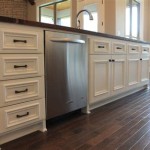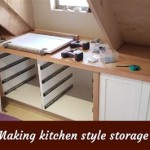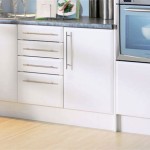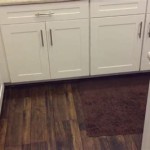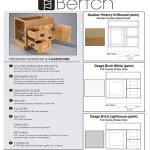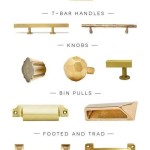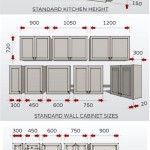Can You Make a Desk Out Of Kitchen Cabinets? A Comprehensive Guide
Repurposing existing materials is a growing trend in home improvement and furniture design. Individuals are increasingly seeking creative and cost-effective alternatives to traditional furniture purchases. Kitchen cabinets, often discarded during renovations, present a viable option for constructing a unique and functional desk. This article will explore the feasibility of building a desk from kitchen cabinets, outlining the necessary considerations, materials, and steps involved in the process.
The core concept involves utilizing the structural integrity and storage capacity of kitchen cabinets to form the base of a desk. Standard base cabinets, typically designed to support countertops and withstand considerable weight, offer a robust foundation. Wall cabinets can also be used, albeit with some modifications for stability and height adjustment. The finished product can range from a simple, utilitarian workspace to a sophisticated and custom-designed desk, depending on the approach and aesthetic vision.
Evaluating the Suitability of Kitchen Cabinets for Desk Construction
Before embarking on a desk-building project using kitchen cabinets, thorough evaluation of the available cabinets is crucial. Several factors influence the success and practicality of this endeavor. The first aspect to consider is the condition of the cabinets. Cabinets that are significantly damaged, warped, or heavily infested with pests are unsuitable for repurposing. Minor imperfections, such as scratches or dents, can often be addressed with refinishing techniques.
The size and dimensions of the cabinets also play a significant role. The cabinets must be appropriately sized to create a desk of the desired dimensions. Standard base cabinets are typically 34.5 inches tall, which is a comfortable height for most individuals when combined with a suitable desk surface. Wall cabinets, generally shorter, may necessitate the addition of legs or a platform to achieve the appropriate height. The width and depth of the cabinets will determine the overall footprint of the desk and the available storage space.
The style and material of the cabinets should also align with the intended desk design and the overall aesthetic of the workspace. Cabinets constructed from solid wood offer greater durability and can be easily refinished. Laminate or veneer cabinets, while often more affordable, may be more challenging to refinish and may be less durable. The color and design of the cabinet doors and hardware should also be considered, as they will contribute to the overall appearance of the finished desk.
Essential Materials and Tools for Building a Cabinet Desk
Constructing a desk from kitchen cabinets requires a selection of essential materials and tools to ensure a successful and durable outcome. In addition to the kitchen cabinets themselves, a suitable desk surface is necessary. This surface can be crafted from a variety of materials, including solid wood, plywood, butcher block, or even a repurposed countertop. The dimensions of the desk surface should be carefully measured to ensure it adequately covers the cabinets and provides sufficient workspace.
Fasteners are crucial for securely attaching the cabinets to each other and to the desk surface. Wood screws of appropriate length and gauge are typically used for this purpose. Construction adhesive can also be used in conjunction with screws to provide added strength and stability. Metal brackets and corner braces can further reinforce the connections between the cabinets and the desk surface.
Finishing materials are essential for protecting the desk and enhancing its appearance. Paint, stain, varnish, or polyurethane can be used to seal and protect the wood surfaces. Primer is typically applied before painting to ensure proper adhesion and coverage. Sandpaper of varying grits is needed for smoothing surfaces and preparing them for finishing. Hardware, such as drawer pulls and knobs, can be replaced to personalize the desk and complement the overall design.
A range of tools is required for cutting, drilling, and assembling the desk. A circular saw or table saw is necessary for cutting the desk surface to the desired dimensions. A drill is needed for creating pilot holes for screws and for installing hardware. A screwdriver or drill driver is used to drive screws into the wood. A level is essential for ensuring the desk is level and stable. Measuring tape, a square, and a pencil are used for accurate measurements and marking.
Step-by-Step Guide to Assembling a Desk from Kitchen Cabinets
The assembly process for a desk built from kitchen cabinets involves a series of carefully executed steps. The first step is to prepare the cabinets. This includes cleaning the cabinets thoroughly to remove any dirt, dust, or debris. Any necessary repairs, such as filling holes or sanding rough edges, should be completed at this stage. If desired, the cabinets can be painted or stained to achieve the desired color and finish.
The next step is to arrange the cabinets in the desired configuration. The cabinets can be placed side by side to create a long, continuous desk, or they can be arranged in an L-shape or U-shape to maximize workspace. The cabinets should be positioned on a level surface and secured to each other using screws and construction adhesive. Clamps can be used to hold the cabinets together while the adhesive dries.
Once the cabinets are securely connected, the desk surface can be attached. The desk surface should be centered over the cabinets and secured using screws and construction adhesive. Pilot holes should be drilled through the desk surface and into the cabinet frames to prevent splitting the wood. Metal brackets and corner braces can be used to reinforce the connection between the desk surface and the cabinets.
After the desk surface is attached, any remaining hardware, such as drawer pulls and knobs, can be installed. The desk can then be finished with a final coat of paint, stain, or varnish to protect the surfaces and enhance its appearance. Any exposed edges or seams can be covered with trim or molding for a more finished look. Finally, the desk can be placed in its desired location and any wires or cables can be organized and managed.
Beyond the basic steps, there are options to customize the desk build. Consider adding keyboard trays, cable management solutions, or built-in lighting for enhanced functionality and ergonomics. Utilizing different cabinet depths and configurations can create tiered workspaces or integrated shelving. The possibilities are limited only by imagination and available resources.

How To Create A Diy Office Desk With Kitchen Cabinets

How To Create A Diy Office Desk With Kitchen Cabinets

Diy Office Desk House Of Hawkes

How To Create A Diy Office Desk With Kitchen Cabinets

How To Convert A Kitchen Desk Into Pull Out Trash

5 Reasons Why You Should Use Kitchen Cabinets For Your Home Office

Diy Built In Desk Makeover With Crown Molding Tutorial The Inspired Work

Built In Desk Le Bois Home
Desk In The Kitchen Is It A Feature Of Past Designed

Craft Desk From Kitchen Cabinets And Countertop Longer With More Workspace For John Built In Desks
Related Posts


